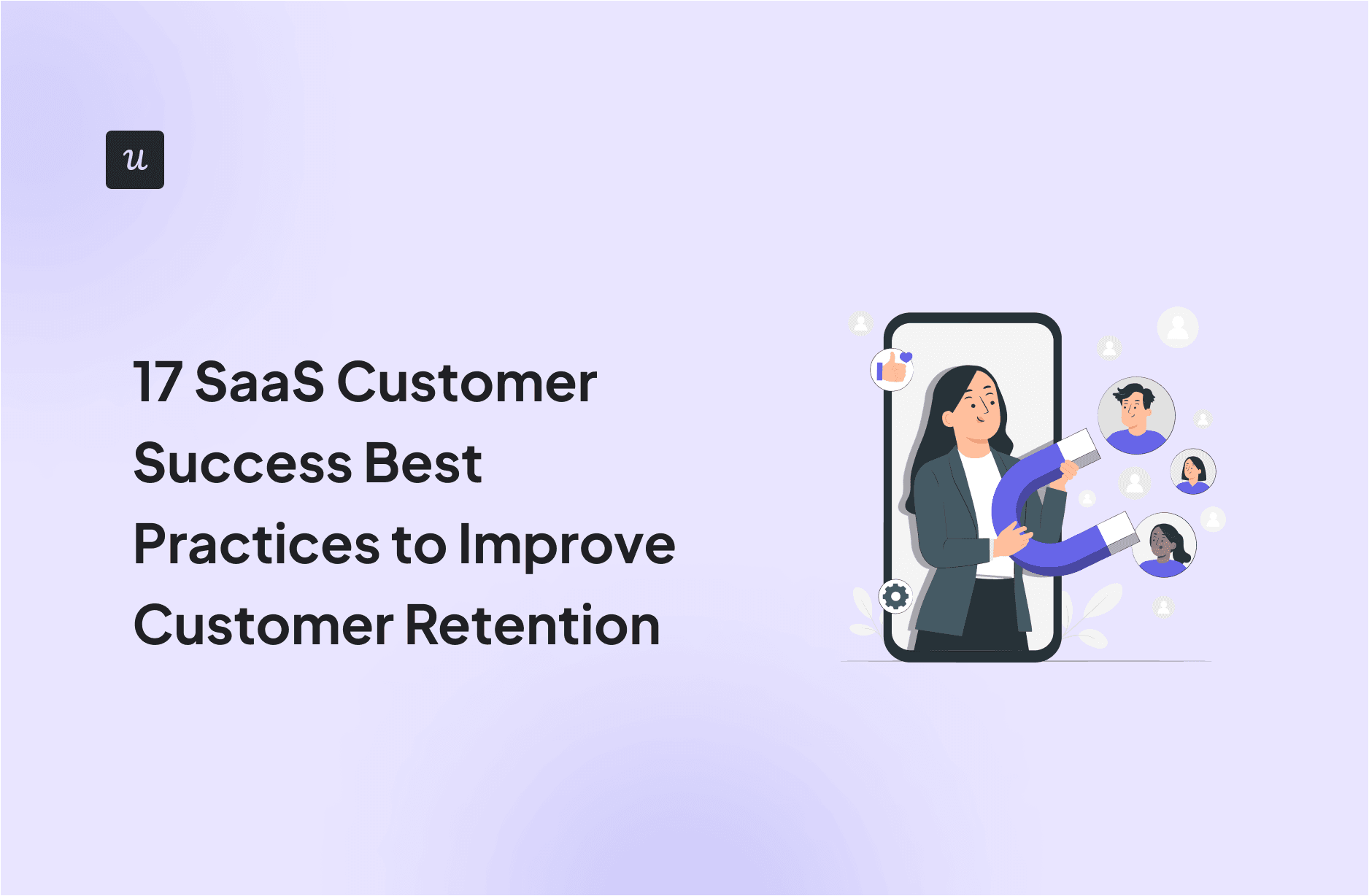
17 SaaS Customer Success Best Practices to Improve Customer Retention
In SaaS, it’s advised to follow customer success best practices to ensure that users achieve their desired outcomes with your product and become loyal advocates for your brand.
But what strategies work?
In this article, we’ll share 17 best practices that you can implement today to increase retention, revenue, and engagement.
How do you currently personalize your user onboarding experience?
Personalizing the customer onboarding process is a core tenet of SaaS customer success best practices. Effective personalization can involve segmenting users by role or goals to provide a tailored journey from the start.
Try Userpilot Now
See Why 1,000+ Teams Choose Userpilot

Summary of SaaS customer success best practices
- Customer success builds long-lasting relationships, increases customer retention, lifetime value, and advocacy, and informs product development.
- Teams of customer success are responsible for building playbooks, managing churn, streamlining onboarding, enhancing customer experiences, driving account expansion, and gathering feedback.
- 17 customer success best practices you can apply in any SaaS include:
- Tailoring the onboarding experience using customer data to increase retention and success.
- Sending email sequences post-sign-up to guide customers through the product.
- Use progressive disclosure to avoid overwhelming users.
- Offering personalized demos to show the product’s value and encourage deeper engagement.
- Implementing an onboarding checklist to help users progress through the customer journey.
- Introducing secondary features to exceed expectations and customer satisfaction.
- Incorporating gamification like badges and progress bars to make the user experience more engaging.
- Using targeted in-app messages to guide users through key features effectively.
- Providing educational content to keep users engaged and informed.
- Building an in-app knowledge base to address common issues and reduce user friction.
- Triggering upsells strategically based on user engagement and value addition.
- Collecting feature requests to align product development with user needs.
- Announcing new features contextually to specific user segments to increase their adoption.
- Sending in-app surveys to gather relevant feedback and iterate your strategy.
- Encouraging referrals and reviews to expand word-of-mouth.
- Tracking user behavior to identify and address potential churn risks.
- Triggering exit surveys to understand reasons behind churn and improve customer experience.
- Key metrics to measure the impact of your customer success strategy include LTV, CSAT, NPS, churn rate, and retention rate.
- The best customer success tools include Userpilot, ChurnZero, and Gainsight.
- Implement the customer success best practices with Userpilot code-free. Book a demo to give it a try.
What is customer success?
Customer success is the practice of ensuring customers get their desired outcome when using your SaaS.
It involves understanding your customers’ needs, goals, and challenges—as well as providing them with the right solutions, support, and guidance to help them succeed.
Why is customer success important for SaaS?
Customer success is essential for any SaaS business, as it provides opportunities to build long-lasting relationships with customers as they succeed with your product.
This leads to a great number of benefits, including:
- More customer retention and less churn. Helping your customers achieve their desired outcomes reduces the likelihood of them switching to a competitor.
- Increased customer lifetime value (LTV) and revenue. Delivering value to your customers throughout their journey creates more opportunities for upselling, cross-selling, and referrals.
- Improved customer advocacy and word-of-mouth. By exceeding your customers’ expectations with a personalized product experience, they will be more likely to recommend your product to their peers, colleagues, and friends.
The role of your customer success team
In short, customer success teams are responsible for ensuring your customers achieve their desired outcomes while using your product.
Doing this involves multiple roles, including:
- Building and implementing a customer success playbook that can provide the best chances of success to users.
- Managing churn and customer retention, making sure that users stay with the brand as much as possible.
- Designing a frictionless onboarding process to ensure users can find value in the product as soon as possible.
- Enhancing the customer experience to make it as smooth as possible.
- Driving account expansion by identifying upselling opportunities in-app.
- Collecting customer feedback through in-app surveys to understand customer’s sentiments about your product.
17 Customer success strategies & best practices to implement in your SaaS
Let’s explore 17 customer success strategies that can be implemented in SaaS:
1. Personalize customer onboarding process based on customer data
Providing a personalized onboarding experience opens the door to driving more customer success and increasing customer retention.
The best way to do it is by segmenting your user base and creating a relevant onboarding sequence for each.

For instance, you can use a welcome survey to gather information such as the user’s industry, their role within their organization, or their main motivation for using your product. Then craft an onboarding path that addresses their specific jobs-to-be-done (JTBD) and responsibilities.
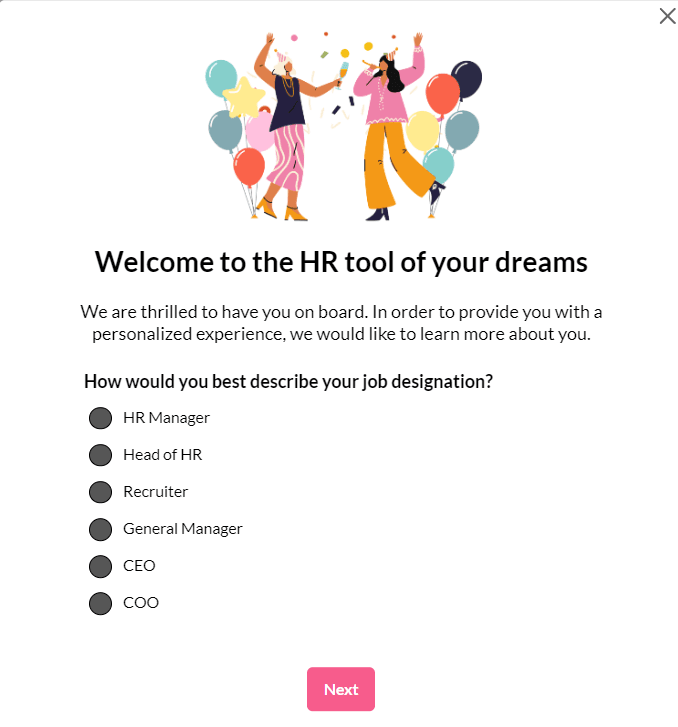
2. Add additional value to customers with onboarding emails
Onboarding emails are essential in nurturing a positive relationship with new users or customers by providing them with a structured introduction to your product or service.
For this, you can create an email sequence that triggers automatically after sign-up. You can take this as an opportunity to simply give a warm welcome to your users, or send emails that guide users through the product’s functionalities step by step.
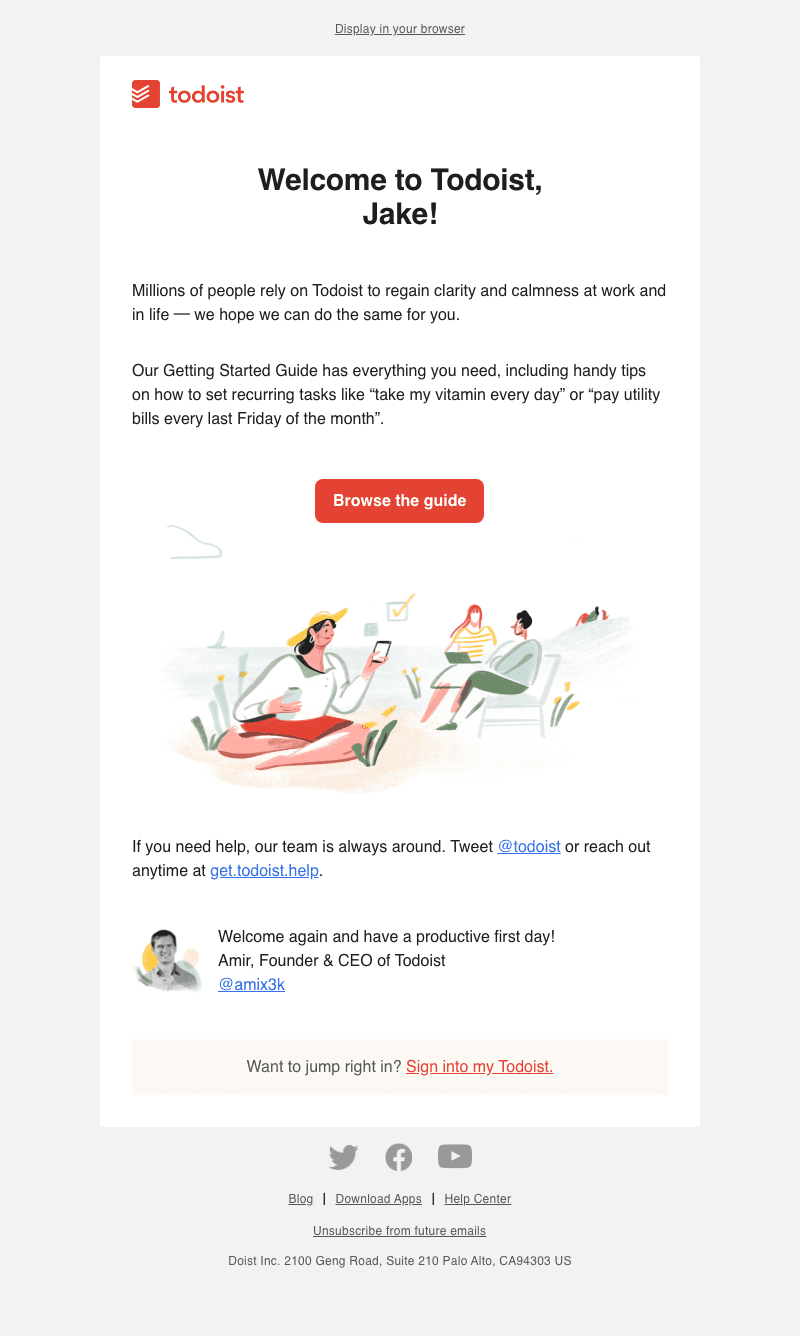
3. Use progressive disclosure in your product UX
Progressive disclosure in UX is about showing only the most essential elements upfront and providing access to additional features as needed.
It’s super helpful for customer success teams as it allows users to navigate the product without feeling overwhelmed.
To apply it, you have to design interfaces that intuitively expand to reveal deeper levels of navigation. Initial menu items should be broad, allowing users to drill down into more specific features without increasing their cognitive load.
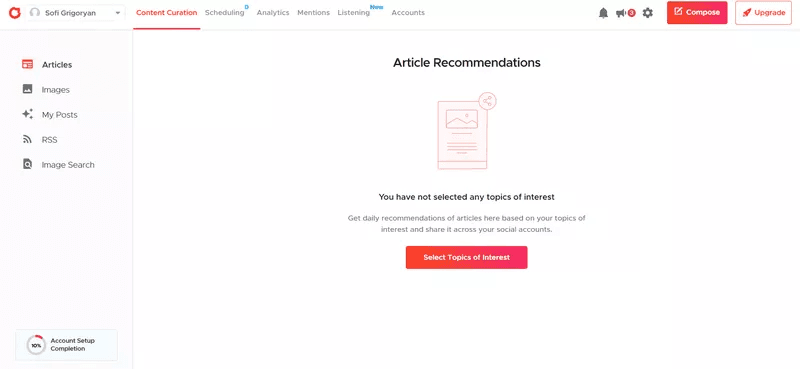
4. Increase customer lifetime value with personalized demos
Product demos are a great tool for customer success managers to help users realize the value of your product.
For instance, you could invite customers to schedule a live demo. Then show them how your product differs from the competition, address their job-to-be-done (JTBD) with personalized sessions, and train your users to use your app in real life.
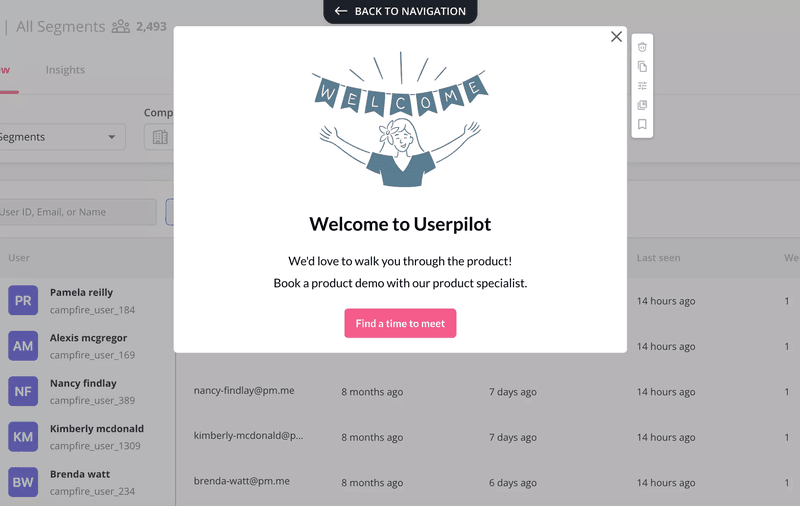
5. Use an onboarding checklist to help users progress through the customer journey
Adding an onboarding checklist helps users achieve the activation stage faster. It serves as a centralized hub where users can see all the necessary steps for getting started in one place.
To create an effective checklist:
- Add key tasks that lead to activation.
- Add a progress bar so users can know how much work is left for them.
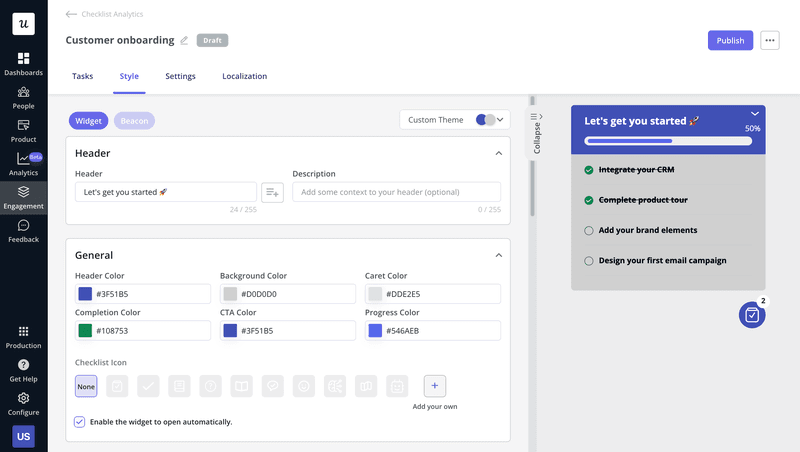
6. Meet and exceed customer expectations
Secondary onboarding is essential to ensure customers can experience real success with your product.
That said, once your users have adopted the core features, you should keep introducing them to secondary features that can provide even more value, exceed their expectations, and increase customer delight.
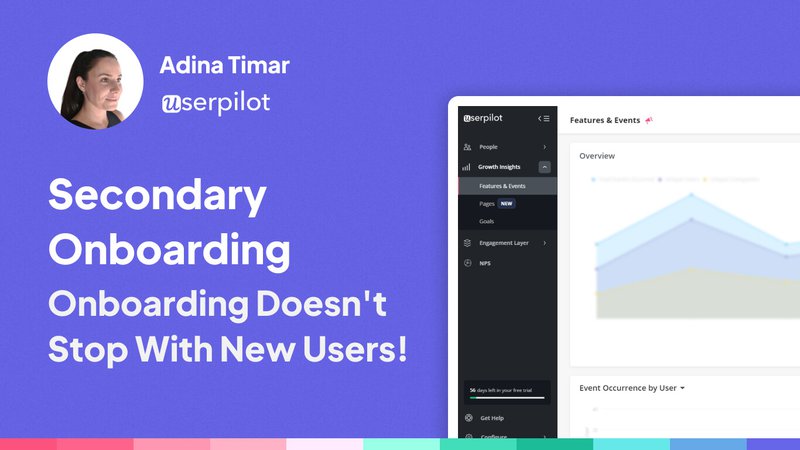
7. Increase customer engagement with gamification
With gamification, you can provide a more entertaining experience and create positive reinforcement to keep users engaged and achieve success with your product (i.e., an engagement loop).
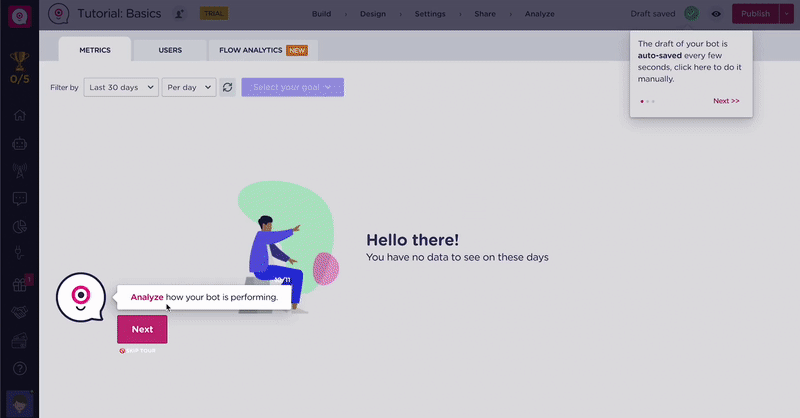
For this, you can add elements such as badges, daily quests, progress bars, and levels for a more exciting onboarding experience—creating a positive loop in the user that makes their path to success more enjoyable.
8. Improve customer satisfaction score with in-app guidance
In-app guidance is a very engaging way to onboard users effectively. It helps users understand your product better and enhances their experience by encouraging exploration.
To use them, identify the features that are core to your product and align with your user’s jobs to be done. Then create small, concise messages to educate customers about each of these features. And finally, set them up to pop out when a customer starts engaging with said feature.
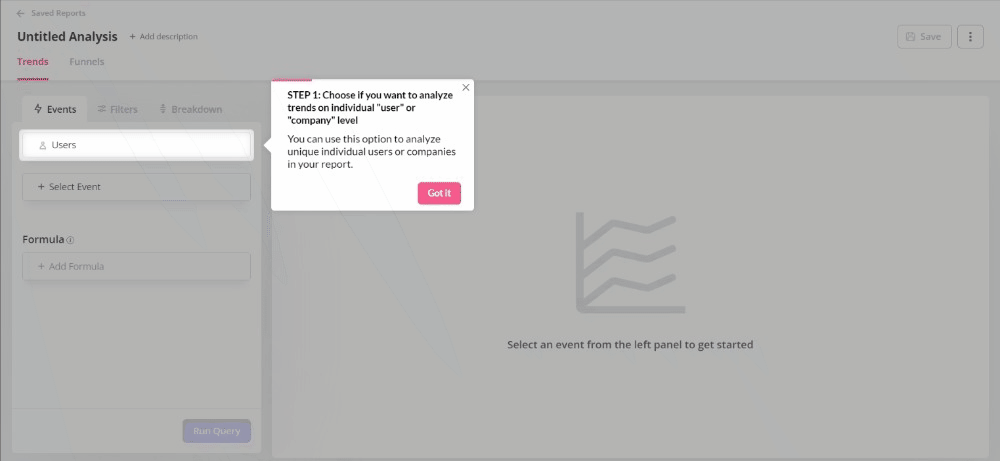
For example, instead of showing a generic product tour that users are likely to skip, you can implement an interactive walkthrough to guide users step-by-step with progressive onboarding.
9. Drive customer success efforts with customer education
Educating customers about your product is a constant, never-ending task. But when done well, it will keep users engaged with your app as they find success with it.
This can involve engaging existing users with educational content such as webinars, slideouts, or tutorials and triggering them when relevant.
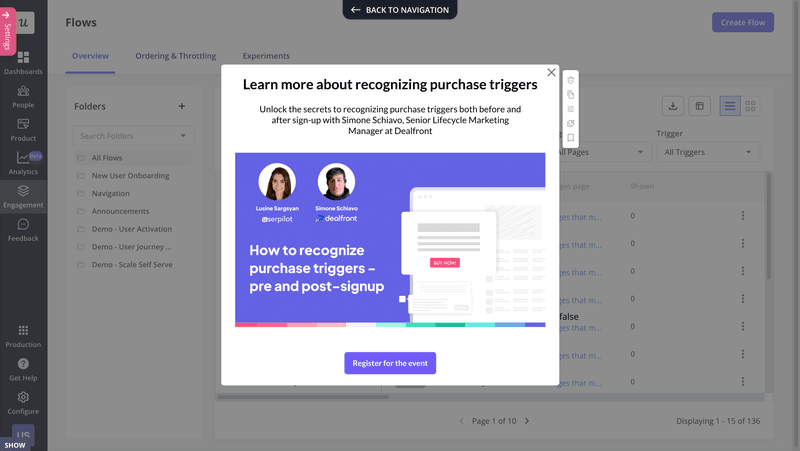
10. Avoid customer frustration with self-service knowledge bases
A great opportunity to offer a top-notch customer experience is through an in-app resource center. It prevents users from leaving your app to solve their issues and experiencing friction.
To create an effective knowledge base:
- Identify common issues that make customers drop off and disengage.
- Survey your users, review your support tickets, and examine your usage data to see what’s causing friction and pushing customers away.
- Create help resources in different formats to directly tackle these challenges. It can include FAQs, tutorial videos, step-by-step guides, or help articles.
- Organize your resources in content modules so users can find resources that are relevant to them.
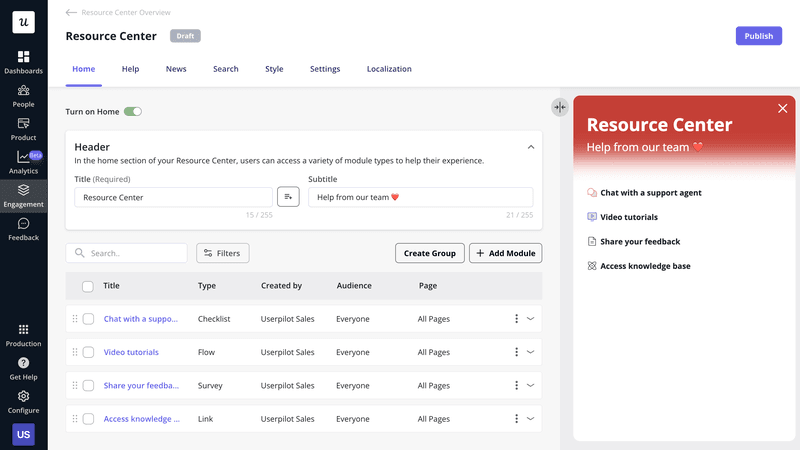
11. Leverage upselling opportunities
When done well, adding more upgrade prompts can drive more sales and increase your customer lifetime value.
But, instead of bombarding users with upselling messages, monitor product usage and prompt users to upgrade their plan only when it adds value.
For example, for active users who use the AI feature frequently, you can trigger an upgrade prompt that offers a premium plan with unlimited AI credits:
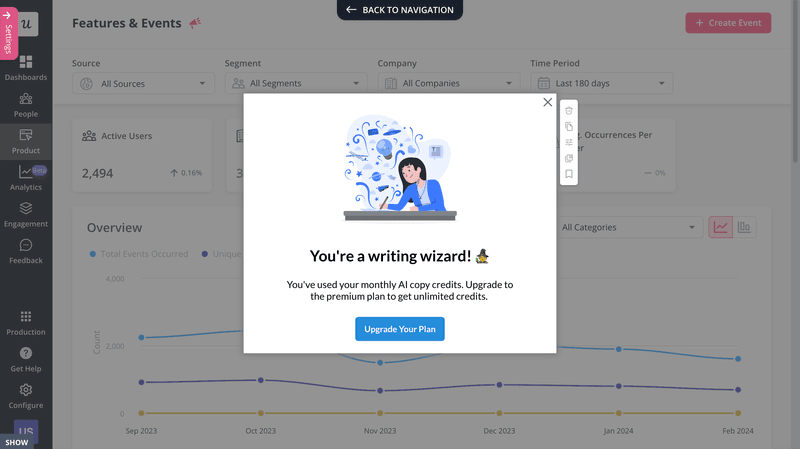
12. Align product and customer success with feature requests
Collecting feature requests is a simple, yet effective way to align your product roadmap with your customer needs.
One passive way to do this is by adding a feature request widget so users can tell you how you could make the product more useful, engaging, and competitive (without any friction).
You can also send a feature request survey to tell what features are the most expected from regular users—just like in the screenshot below.
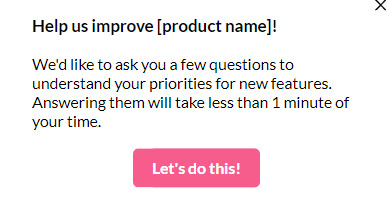
13. Introduce new features contextually to improve feature adoption
Announcing new features encourages existing users to engage with them.
But to avoid annoying users, you should trigger them contextually on a segmented audience based on feature engagement, feature requests, or user personas.
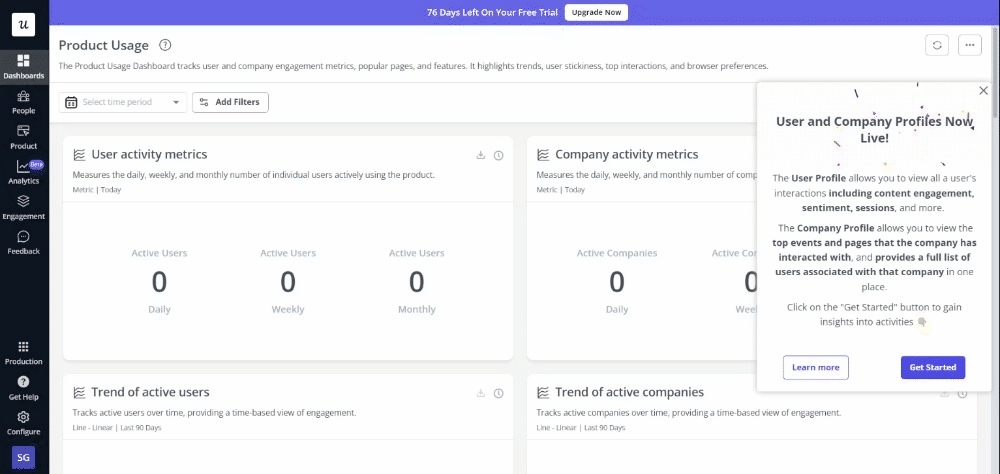
14. Continuously collect customer feedback and improve customer experience
The best way to improve customer success is by asking your existing users directly.
For this, segment your users and target in-app surveys such as CES (customer effort score), CSAT, and NPS surveys to understand their points of view.
This lets you collect feedback that’s relevant to their specific needs, iterate your customer success playbook, and close the feedback loop.
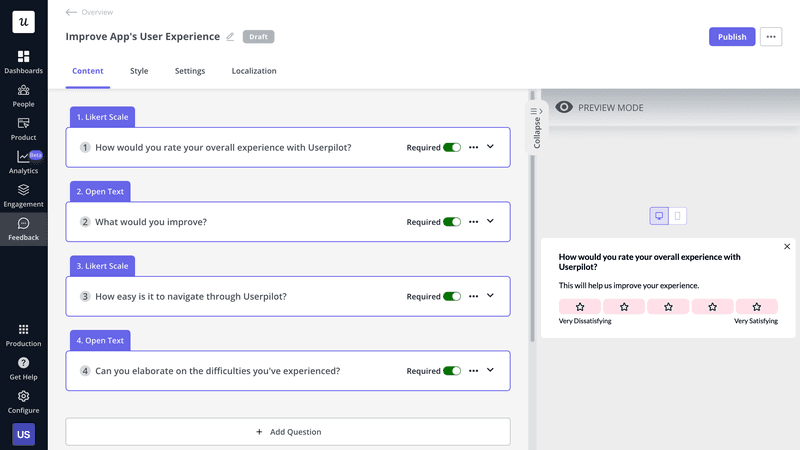
15. Drive customer acquisition with word-of-mouth marketing
One way to acquire customers is to reward your existing users for writing reviews or bringing in referrals through word-of-mouth.
This can involve asking your most loyal users to write a G2 review.
But, you might as well set up a loyalty program where customers are rewarded for inviting teammates or writing a review, and those points can be exchanged for credits, free months, etc.
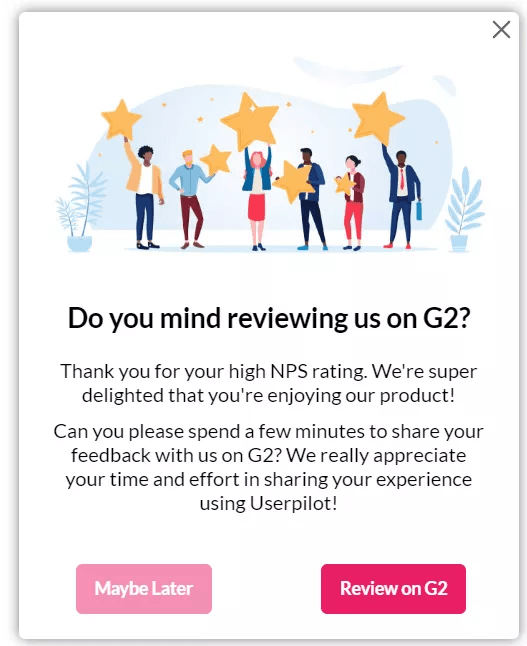
16. Monitor in-app customer behavior to identify at-risk customers
Monitoring user behavior provides invaluable insights into which users are at risk of churn.
For this, you can use tools (like Userpilot) to measure product usage metrics like login frequency, feature utilization rate, and session duration.
So if there’s a drop in login frequency—for instance—you can segment these users and come up with a targeted re-engagement strategy to nurture them (think of personalized emails, video tutorials, or even one-on-one consultations when feasible).
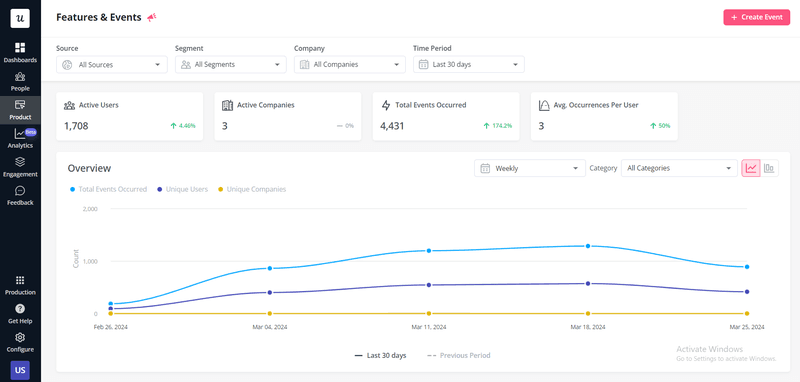
17. Survey churned customers to identify why they didn’t succeed
No matter how good your customer success strategy is, churn is inevitable.
But with a user offboarding process, you can learn why a customer leaves, improve the product experience for the other users, and even reach out to ex-customers once problems are fixed.
To do this, you can trigger a churn survey when the user hits “cancel.” Ask what went wrong and improve your service to get a step closer to building an effective customer success process.
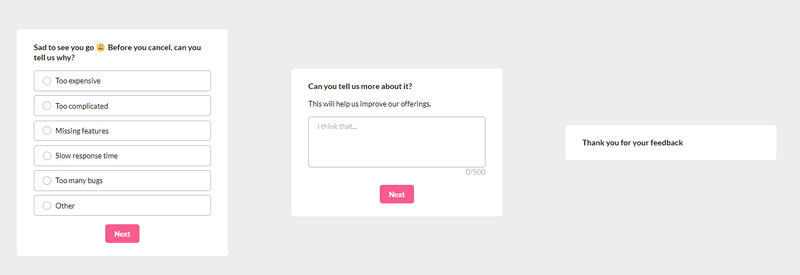
Key metrics to measure the impact of your customer success strategy
Now that you know the tactics, how do you know if your customer success efforts are working? How do you measure the impact of a SaaS customer success team and strategies?
Here are some of the most important metrics to track:
- Customer Lifetime Value (LTV): LTV calculates the total revenue a customer generates for your business over their entire relationship with you. Its formula involves multiplying the average monthly income per customer by the average customer lifespan in months and subtracting the average cost of acquiring and serving a customer.
- Customer Satisfaction Score (CSAT): CSAT is a simple and direct way of asking your customers how satisfied your customers are with your product. It is usually measured by asking customers to rate their satisfaction on a scale of 1 to 5, or 1 to 10, where higher scores indicate higher satisfaction.
- Net Promoter Score (NPS): Measures the overall sentiment that your user base has over your product. It’s calculated by subtracting the percentage of detractors from the percentage of promoters.
- Churn rate: The rate at which customers are unsubscribing from your app. It’s calculated by dividing the number of lost customers by the total number of customers acquired during the same period.
- Customer Retention Rate: Retention is the percentage of customers who stay with you over a given time. It can be calculated by dividing the number of customers at the end of a period by the number of customers at the beginning of the period and multiplying by 100.
Customer success tools
No matter what customer success strategy you wish to execute, you’ll need software to set them up, trigger them, and retrieve data.
So let’s go over the best customer success tools that require no coding skills:
Userpilot: All-in-one customer success software
Userpilot is a customer success platform that offers more than the ability to trigger in-app experiences. You can also create in-app surveys, track user behavior, and get access to advanced product analytics—everything to nurture product growth.
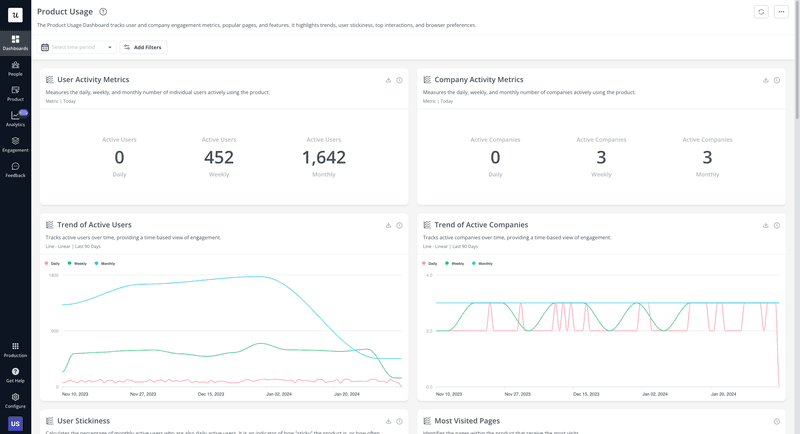
Here’s how Userpilot can help a dedicated customer success manager:
- Get a deep user experience understanding with analytics charts such as funnels (to spot friction), trends (to understand how behavior changes), and paths (to draw the product journey of your users).
- Use feature-tagging and event-tracking to analyze user behavior and identify friction points.
- You can segment your users based on their data and personalize the customer experience.
- A/B tests different in-app flows to see what kind of content generates more engagement.
- Build an in-app resource center to offer self-service support 24/7.
- Collect feedback for your research using a great variety of in-app surveys such as CSAT, CES, and NPS surveys.
There are three main plans: Starter ($499, billed annually 9/mo), Growth and Enterprise (custom pricing).
ChurnZero
ChurnZero is a customer success platform designed to help subscription-based businesses reduce churn and increase customer retention. It can provide real-time insights and proactive management tools to understand customer usage patterns, automate tasks, and engage with customers effectively.
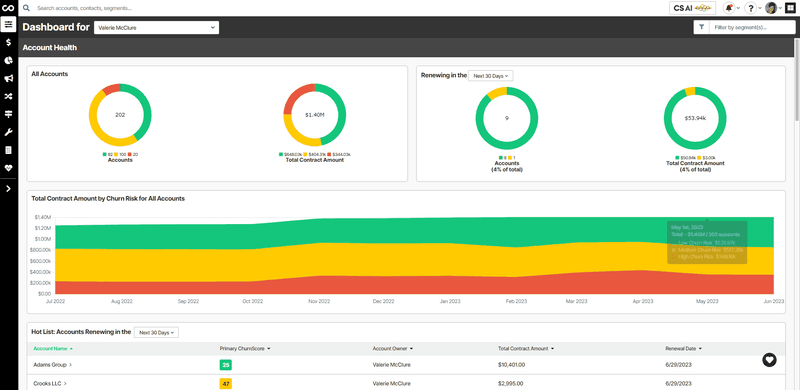
It includes:
- Real-time customer health scores.
- Automated playbooks to trigger specific actions based on predefined customer behavior criteria.
- In-app communications to send messages directly to users within your app.
- Segmentation based on usage data, health scores, and more for targeted actions.
- Detailed analytics tools to track trends, usage, and overall health of customer accounts.
Gainsight
Gainsight is a comprehensive customer success platform that helps companies drive engagement, expand revenue, and foster loyalty. It’s designed to integrate seamlessly with existing CRM systems so you can manage customer relationships effectively.
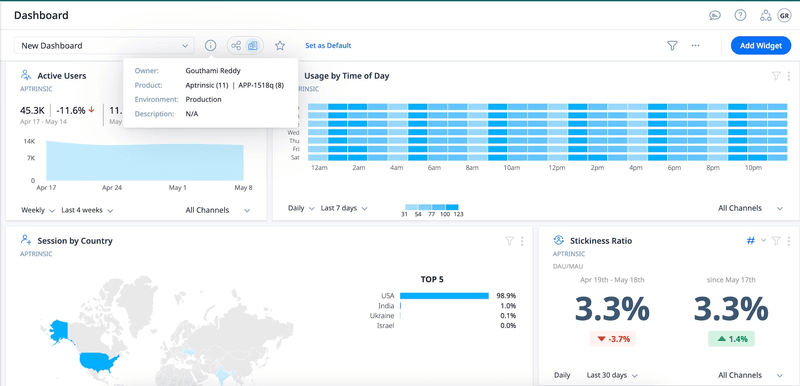
It includes:
- Customizable metrics that provide immediate insights into customer satisfaction and risk.
- Journey orchestrator to automate customer communications for various stages in the customer journey.
- Advanced analytics tools that evaluate customer data to generate detailed reports and forecasts.
- Tools to manage and analyze customer interactions across various touchpoints.
- Revenue Optimization tools that leverage customer data to identify upsell and cross-sell opportunities effectively.
Conclusion
For SaaS companies, retaining customers is as impactful (if not more impactful) than acquiring them.
That means following customer success best practices that keep your customers happy is essential for healthy growth and success.
So now that you know the best practices for achieving SaaS customer success, why not get a Userpilot demo to apply them without coding?







